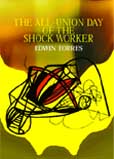 |
|
| lingo | |
| e-vents | |
| books | |
| sound | |
| about | |
| lobes | |
| contact | |
| [ 1 ] [ 2 ] | ||||||
|
> The All-Union Day Of The Shock Worker
> Onomalingua: |
A few years ago, I enrolled in a writing workshop that was taught by Edwin Torres. Each workshop would begin with an exercise that created some sort of chaos. I remember, for instance, one that began with us all writing something down. Then we all got up and began walking around the room screaming out what we had written down. As we did this we wrote down what we heard. Then we went and edited this into a new poem. In another workshop, we laid out 3 x 5 cards all over the floor to make a big rectangle. Then we drew one big drawing on these cards. And then we separated the cards so that we were just left with little bits of the main drawing we had done. Then we wrote out of this bit of drawing we had. These workshops were process-oriented. Writing was presented as something that was in flux and all the better for it. And writing wasn't just written, it was also something sonic and graphic. And it was a complicated improvisational act that was very much dependent upon and stimulated by contact with others in the room. This is what I think it means to be a shock worker. The All-Union Day Of The Shock Worker reads as if it was written out of this space. There is the odd moment of romanticism and the odd moment of straight up philosophy, but in general the poems in Shock Worker seem to be all about what it means to be moving through life with languages and their attendant chaos. Shock Worker has five sections to it. It begins with poems that look more or less like poems in the section title "Unfinished Beginnings." Then the section "What What Now Now" which is a score to a play by Steve Cannon (these poems might be more interestring if read in the context of the play; on their own, this is the weakest part of the book). Then "Canyon Suite: A Parallel Text in Five Acts" which was written in the same manner but is more successful as it reads as a very funny series of word plays without the source text. Then "I.E. Zagmm," poems written mainly in an unreadable, at least for me, symbol system although there are brief moments of English and Spanish coherence. And then "A Nuyo-Futurist's Manifestiny," which is a wonderful poem/manifesto/essay and is I think the strongest piece of writing in the book. I plan to make students of the courses I get assigned that have dumb names like "Understanding Poetry" read it for years to come. For readers who might find themselves lost in this work, A Nuyo-Futurist's Manifestiny" will most likely explain it all. It explains language this way: "you set up / different precedents / as a part of / your senses / the other senses will follow / / establish possibility / to allow / explorationing / to allow / unexpectation / to happen." And also, "as LANGUAGE is : what creates us / let's create something greater : than / you or I / let's create us." The us that gets created in these poems is multilingual in all sorts of ways. The manifestiny moves back and forth between English and Spanish. "And I see that I say I am soy muy flaco de HOY…" Shock Worker is grounded in the urban space of New York and, as is often noted about Torres' work, it suggests many influences: Language, Performance, Experimental, Latino, Nuyorican, Slam, Latin American avant garde. There is a certain urban sprawl about his writing that makes it distinctive. At the same time, I believe anyone can join the union of the shock worker. The book comes with a free Shock Worker button that proclaims membership. I wear mine proudly. I urge everyone else to join up.
[ top ]
|
